Phyllis Lyon & Del Martin
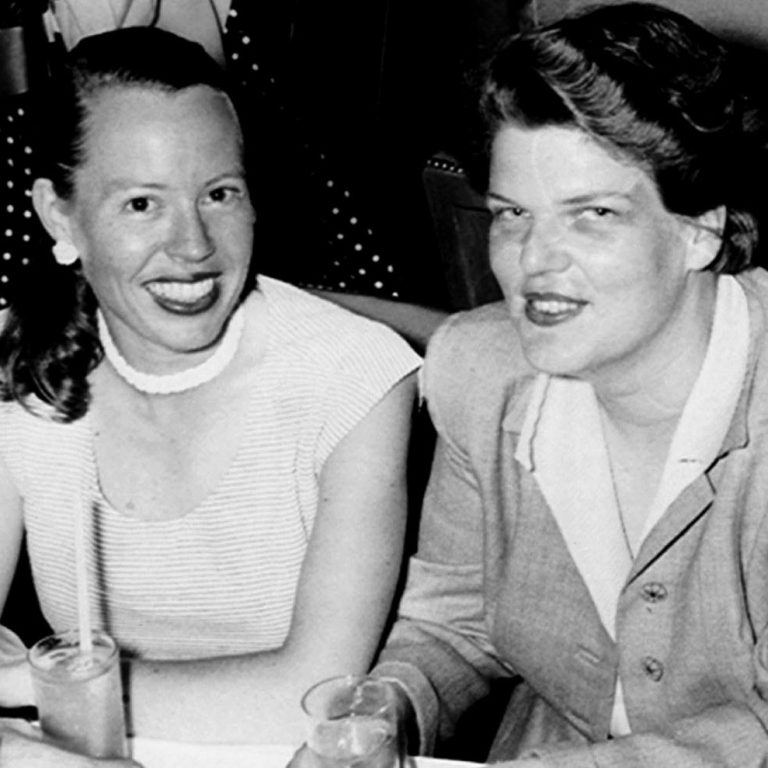 Phyllis Lyon and Del Martin in an undated photograph from the 2003 documentary "No Secret Anymore: The Times Of Del Martin & Phyllis Lyon." Credit: A.F. Archive/Alamy.
Phyllis Lyon and Del Martin in an undated photograph from the 2003 documentary "No Secret Anymore: The Times Of Del Martin & Phyllis Lyon." Credit: A.F. Archive/Alamy.Episode Notes
Phyllis Lyon and Del Martin had no idea that their search for women like themselves would lead them to cofound in 1955 the Daughters of Bilitis, the first organization for lesbians. Along with the Mattachine Society, which was founded in 1950, the two organizations planted the seeds for what would ultimately become an international social and political movement that has fought for the rights of LGBTQ people ever since.
To learn more about Phyllis and Del and the Daughters of Bilitis, we recommend exploring the information, links, photographs, and the episode transcript that follow below.
———
Phyllis Lyon and Del Martin’s papers are housed with the GLBT Historical Society in San Francisco. You can find an overview of the collection here.
Watch a trailer for It’s No Secret Anymore: The Times of Del Martin and Phyllis Lyon. The 2003 film documents both their relationship and their public life, and includes interviews and rare photos.
The Gay and Lesbian Review published an article in 2012 about Del, Phyllis, and the history of DOB. The article includes a fun caricature of Del and Phyllis.
In this picture book for children, Del and Phyllis point out landmarks they can see from the window of their home in San Francisco. They also talk about the changes they have seen throughout their lives for women and gay people.
Here’s a brief overview of the history of the Daughters of Bilitis (DOB). To learn more about the Daughters of Bilitis, we recommend Marcia Gallo’s book, Different Daughters: A History of the Daughters of Bilitis and the Birth of the Lesbian Rights Movement.
Since Phyllis and Del were both journalists, publishing a Daughters of Bilitis magazine, The Ladder, was a natural extension of the organization’s work. Malinda Lo wrote about the history of The Ladder in a 2005 article for AfterEllen.com. Take a tour of a GLBT Historical Society exhibit about The Ladder in this video. You can read the November 1965 edition of The Ladder here. The December/January 1970/1971 issue of The Ladder includes Del’s essay (aka, “Del’s manifesto”), “If That’s All There Is.”
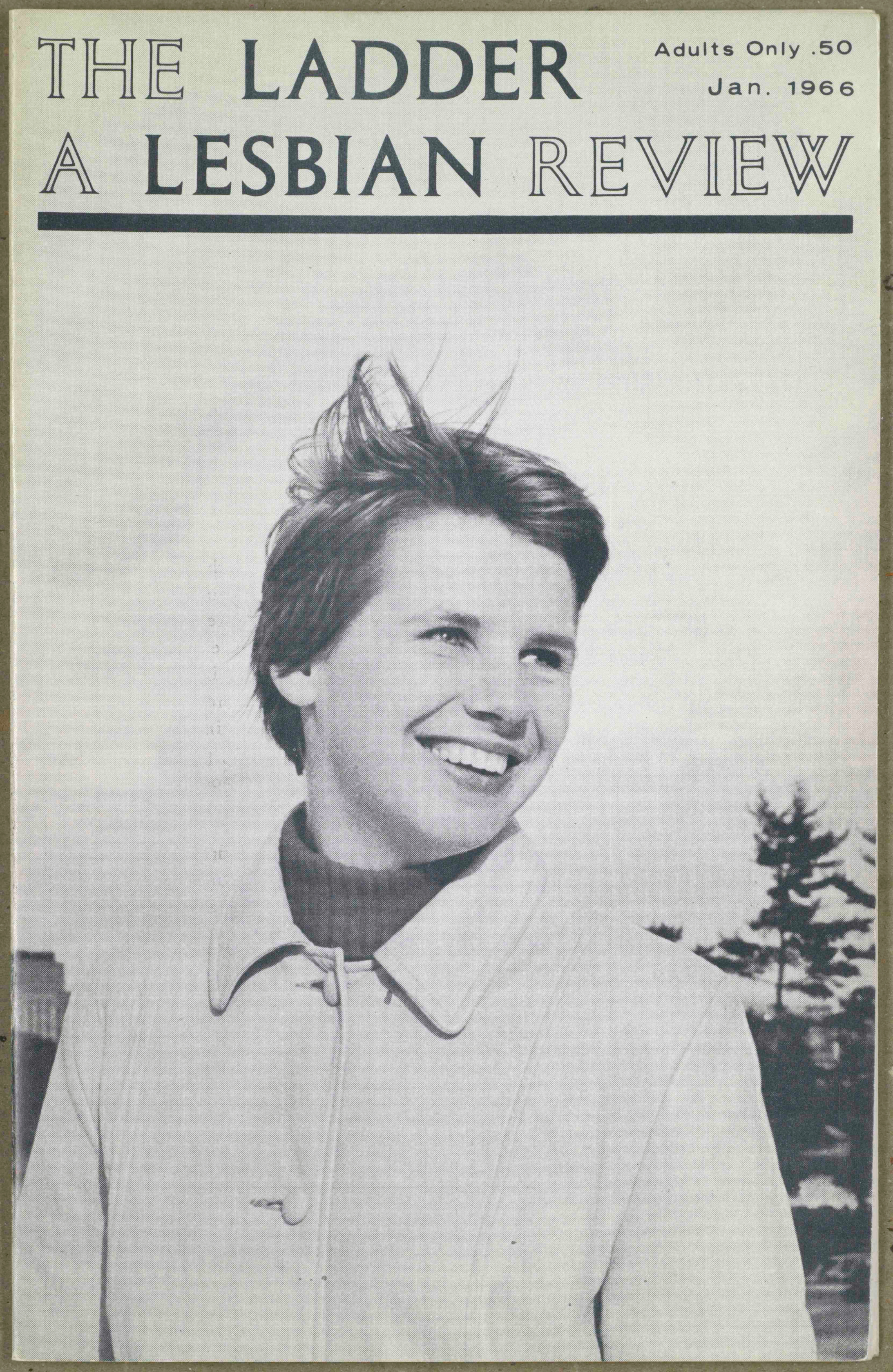
In their original, full-length Making Gay History interview, Del and Phyllis mention the 1928 novel The Well of Loneliness, which feature a lesbian main character. The New York Public Library posted an article about it during Banned Books Week in 2013. Del and Phyllis also mention The Price of Salt, which you can find here. In 2015, when Carol, a film adaptation of the book, was released, New Republic published an article about the novel.
The Daughters of Bilitis held its first national convention in San Francisco in 1960. Have a look at this DOB newsletter in which they announce the convention. In their Making Gay History episode Phyllis and Del talk about DOB’s 1964 convention in New York and how the FBI couldn’t figure out where it was held, but the New York Times managed to find out and wrote an article about it on June 21, 1964. You can read an excerpt from The Ladder of a report about the 1964 convention here.
Phyllis and Del co-authored Lesbian/Woman, which was published by Glide Publications in 1972. The book includes case histories and personal experiences that document lesbian attitudes, life styles, and challenges of living in a heterosexual social structure.
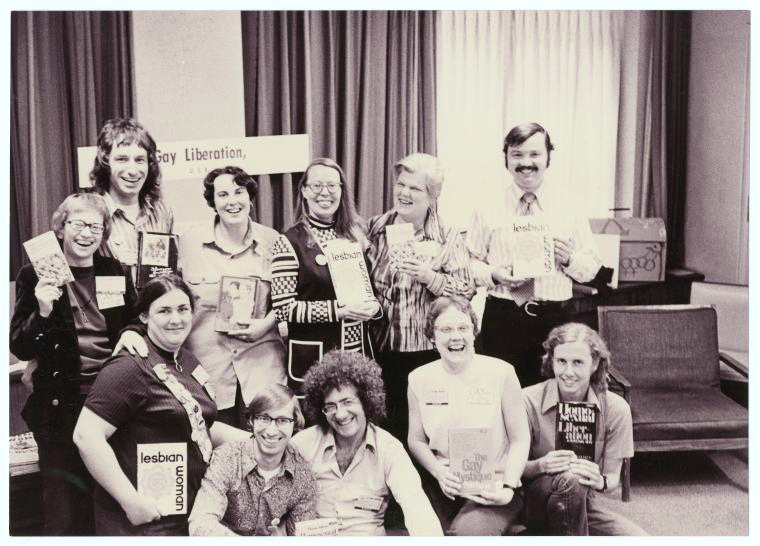
Del and Phyllis got married—twice! As reported in the Washington Post, the first time was in 2004 when then San Francisco Mayor Gavin Newsom ordered the city to issue marriage licenses to same-sex couples, despite the fact that such marriages weren’t yet legal.
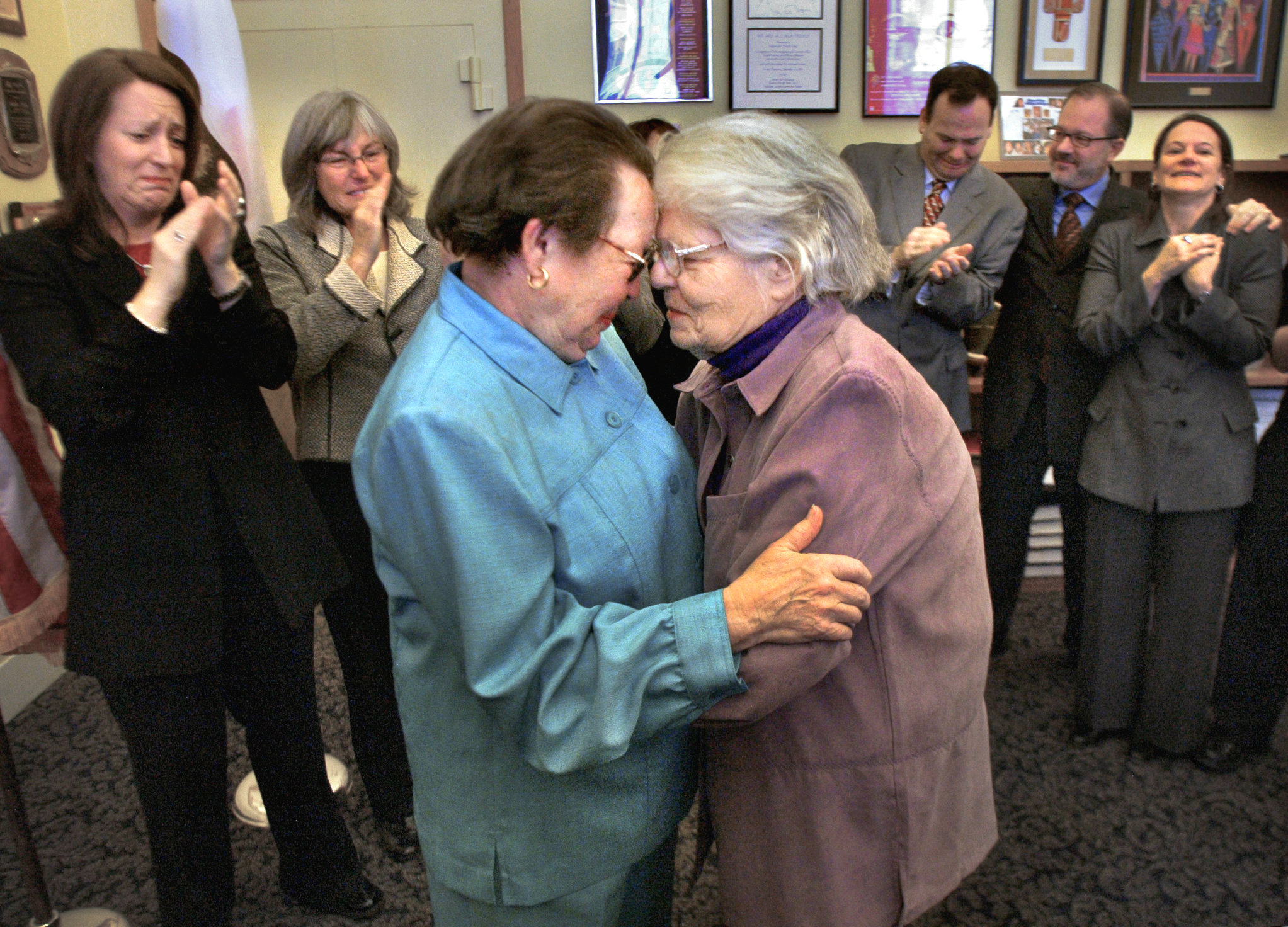
In 2008, when same-sex marriage was legalized in California, Del and Phyllis were the first couple to get married in San Francisco. Read about their June 16, 2008, wedding in this San Francisco Chronicle article, which includes a video and photo gallery that will move you to tears.
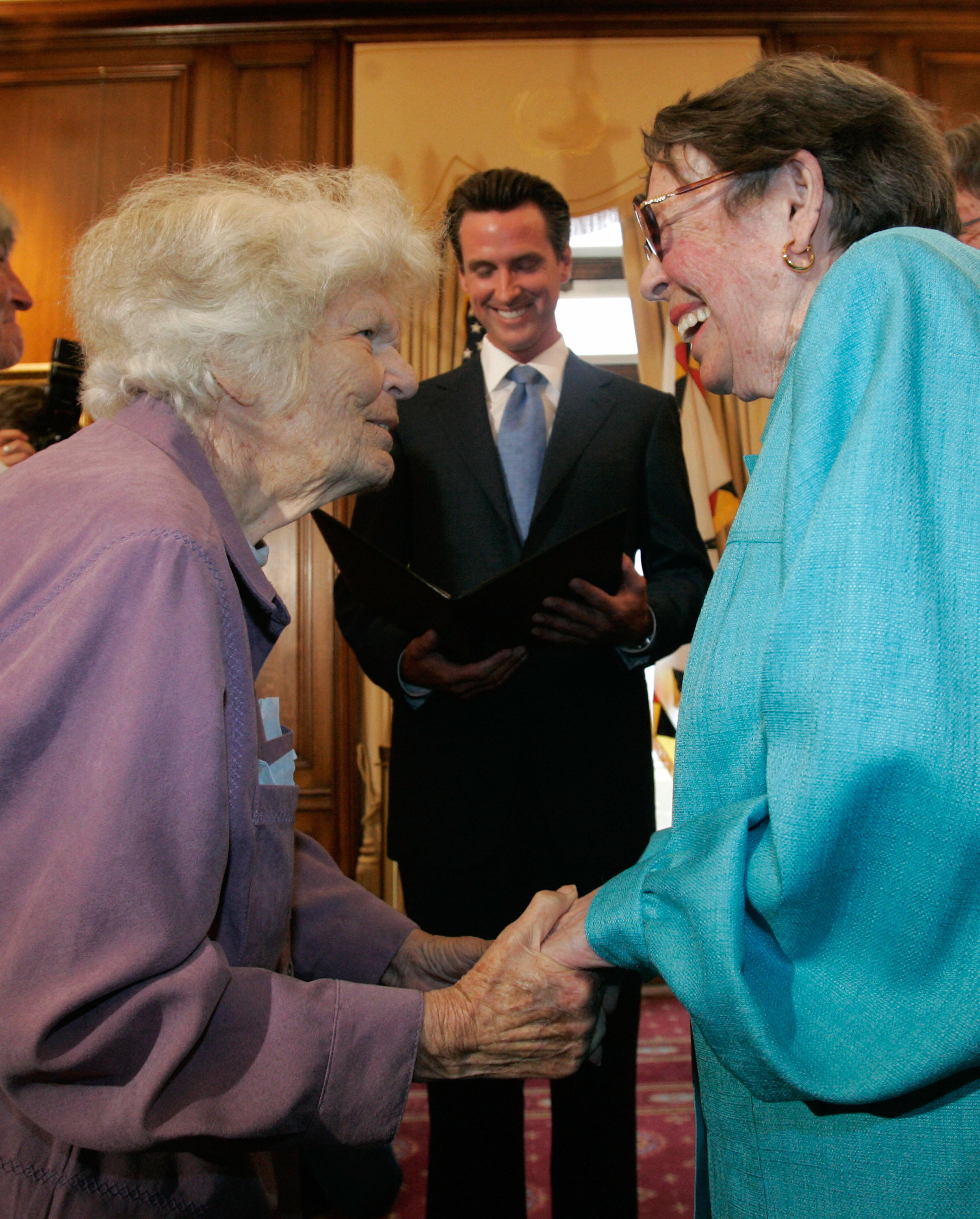
Del Martin died on August 27, 2008, just two months after she legally wed Phyllis Lyon. Both the San Francisco Chronicle and The New York Times published obituaries.
———
Episode Transcript
I’m Eric Marcus and this is Making Gay History!
By the time I sat down to interview the dynamic duo Phyllis Lyon and Del Martin in 1989, I thought I knew a lot about them because of their decades-long and high-profile roles as LGBTQ civil rights activists. Phyl and Del founded Daughters of Bilitis in 1955—the first organization for lesbians. Their names and faces kept popping up in my research. Phyllis with her black ponytail, big glasses, and mega-watt smile. Del with her round face, heavy-lidded eyes, and silver close cropped hair. From recorded interviews, I knew their voices, too. Phyl’s was full of smoke. Del’s was a smoother grade of gravel, the volume always kept on a whispery low.
Phyllis and Del found each other while working at the same magazine in Seattle in 1950. Three years later, on Valentine’s Day 1953, they moved into an apartment on Castro Street in San Francisco. The Castro was a very different neighborhood back then—working class, Catholic, very straight. While Phyllis and Del had each other, they longed to find community. And that longing led them to plant the seeds of a national social movement.
There’s one thing you need to know before you hear Phyllis and Del speak for themselves. I asked them a dumb question about their relationship based on a stereotype I’m not sure I even believed in. I still cringe when I hear myself asking them about their quote, classic butch/femme relationship. Fortunately for me, Phyllis and Del were tolerant of what I didn’t know and were very patient in helping me understand what I needed to learn.
So here’s the scene. Across the kitchen table from me sit Phyl and Del. They look just like their pictures, maybe a bit older. Phyllis is 64. Del is 68. I clip a microphone to each of their blouses and press record.
———
Interview with Del Martin and Phyllis Lyon. Thursday, July 27, 1989. Tape one, side one.
Eric: So just introduce yourself by name.
Phyllis: Okay, I’m Phyllis Lyon.
Del: And I’m Del Martin.
Who knew about homosexual? Um, even lesbian, we didn’t know those terms. Um, so here you are feeling this, whatever it is, but you don’t know even how to define it.
Eric: This sounds like a nightmare. So, you…
Del: So that was what was happening. Everybody thought, “I am the only one.”
Eric: So it wasn’t as if you could go to the library… But once you had the word, you could go to the library.
Phyllis: Yeah, but they didn’t have anything anyhow, then. Then all you found out was that you were illegal, immoral, and sick.
Eric: So this was, this was hardly a superb foundation for the beginning of a massive nationwide gay rights movement.
Phyllis: Well not even for feeling good about yourself.
Del: I think the things that we were working on in the ‘50s in the Daughters of Bilitis anyway, was trying to build our self esteem, I mean, begin to say that we were okay in spite of being faced with, as Phyllis said, being immoral, illegal, and sick. I mean that’s heavy duty for a lot of people, and you had the, uh, purges in, you know, the state department, and government, and then there were the raids of the gay bars, there were the purges in the armed services.
Eric: What was life like for the two of you around when DOB started? Your relationship, the dynamic of your relationship, I understand was the classic butch/femme relationship.
Phyllis: Well, I don’t know about the classic…
Eric: If I stumble over words, please tell me. This is new stuff for me, too. I mean, “for me,” I should say, not “too,” but…
Phyllis: It didn’t work for us no matter how we tried. It was true that Del tended to light my cigarettes, okay? But that was as butch as she got sometimes. She doesn’t drive, and I did. You know, she didn’t drive the nails in and I did. She didn’t do any of these butch things.
Del: I’m not at all mechanical.
Eric: But you were, but that’s what you’re supposed to, this was the relationship you thought you were supposed to have.
Phyllis: Yeah, right. I remember thinking, well, now, let’s see, I’ve got to get Del’s breakfast every morning, because that’s what mother did for dad. So I did that for a week. Forget it. None of these things really worked for us and I suspect that was true for most couples.
Eric: Were there role models for you at all? Certainly there were no guide books.
Phyllis: Well, see, I didn’t know really much of anything. I mean, I just had met this person three-and-a-half years before and she said she was a lesbian, and I thought that was the most fascinating thing I’d ever heard. And then when I thought about it, explained a lot about the fact that I had been really attracted to women in high school, etc., etc., but I didn’t, and still was, but I didn’t really have a clue as to what that was all about.
Del: And we didn’t know anybody, you know, and so we knew about the bars in North Beach. And we went down there. And we were very shy. And so, we sort of were more like tourists. Going to the bars and watching everybody and wondering how we fit in. Anyway, we did meet a couple of men who lived around the corner.
Phyllis: Gay men.
Del: Gay men. So we became friends with them.
Phyllis: They were in a butch/femme relationship.
Del: Jerry was a bartender and…
Phyllis: Ricky was very effeminate. He used to dress in drag. He and I used to dress alike sometimes, go out, Halloween and stuff like that. And he stayed home. He didn’t work, did he? So Jerry was supporting him and he stayed home and took care of the house and the cats.
Del: Jerry introduced us to this couple, lesbians.
Eric: And they suggested getting together?
Del: To start this organization.
Phyllis: They, well yeah, Nonny called—she called us and asked us if we wanted to get involved.
Del: And we thought, great, you know, we can meet some other lesbians. That was our main focus.
Eric: This was, you were not thinking, well, we’re going to start a national movement.
Phyllis: Oh no!
Del: We were just gonna meet some lesbians.
Phyllis: And start a social club. That’s what this is. I mean, it was a Sunday, September afternoon, and we were cleaning house. And where would we have gotten the idea about starting a national movement in September of 1955? Nowhere.
Eric: And the idea was what?
Del: To have a social club. A secret social club.
Eric: “Secret” meaning secret membership? Secret everything.
Phyllis: Yeah.
Del: Nonny was into a sort of a structure, you know.
Phyllis: Yeah.
Del: And she was also the one that came up with the name, Daughters of Bilitis. Because she had read, seen this book and it was a long narrative, a lesbian poem. And Bilitis was supposed to have lived at the time of Sappho. And it could appear like we were just like any other women’s lodge.
Eric: So you didn’t think of naming yourselves “The Lesbian Dancing Club” or…
Del: Not hardly.
Phyllis: You know, it wasn’t until 1964 that there was an organization that used the word “homosexual,” “gay,” or “lesbian” or something in it… And the idea was that by calling ourselves the Daughters of Bilitis then people… that lesbians would know what it meant, and nobody else would. I don’t think that was true of lesbians, because none of us except Nonny had ever seen this poem. Anyhow, that didn’t occur to us then either, so.
Eric: Something that started as a group, a social group of eight women evolved. What I’m trying to get a sense of is, did you talk about the place of lesbians in the world, the challenges of being gay, dealing with family?
Phyllis: Well, eventually we talked about all of those things.
Del: Mostly on a personal level. How do you deal with your family? How do you solve this problem or that or…?
Phyllis: Should I tell my parents? How do I tell my parents?
Eric: You hadn’t told your parents.
Del: No.
Phyllis: No.
Del: Not many people told their parents in those days. And one of the problems too, if you were under age, parents would, you know, take you to a shrink or they could have you institutionalized.
Phyllis: And underage was under 21 in those days, too. A lot of women came to DOB who had been either abandoned by their families or had been, had electroshock therapy, or had been thrown into mental institutions, or who had escaped from mental institutions.
Eric: At some point you decided to go ahead with a more activist approach, and there were women who wanted the group to remain a social organization. What happened then?
Del: Well, of the eight of us, there was a split, four and four. And the four wanted a strictly secret social club. And the other foursome was for branching out more. And so the four who wanted a secret social club started another one, so I…
Phyllis: And then the other two women that had been original founders moved to Redding. In the process of discussing and talking and so on, and over a period of time that I don’t remember exactly, we said, alright, we would like to educate the public about the realities of lesbianism, only we didn’t say it in that word. But the, about the truth about lesbianism. By this time we had more members.
Eric: Dozens? A hundred?
Del: Oh, no, we never got to a hundred. Probably a little over a dozen or fifteen or something.
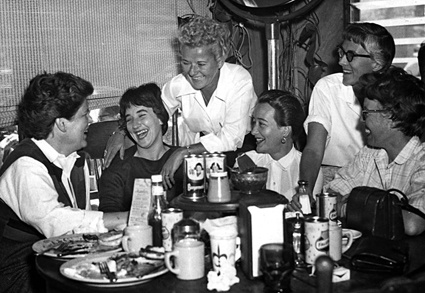
Phyllis: Something like that. This organization was so fragile that Del and I were like peer counselors to every member, and we stopped and pick ‘em up to bring them to the meetings. If anybody had a problem we ran over to pat their heads.
Eric: What made it so fragile?
Phyllis: There was a few of us, and it was so scary.
Del: And the times. There was nothing but fear out there.
Eric: What were people fearful of?
Phyllis: Of losing their jobs. Of losing their jobs, losing their families, losing their minds.
Eric: Could they lose their homes, too? Could they be thrown out of their apartments?
Del: Sure.
Phyllis: Sure. They could be thrown out of their apartments, and I think they were, they could certainly lose their jobs, and they had.
Del: The thing I guess we stressed in the beginning was, DOB was an alternative to the bars that were being raided. Bar people thought, you know, we were crazy…
Phyllis: … we were terrible. First, there were all kinds of rumors, right. DOB was for couples only. Or, and then there was the one about, we had orgies. Then we were communists. And, those are the three that come to mind.
Eric: Did they resent you because you were causing trouble, or potentially were going to cause trouble for them?
Phyllis: I don’t think that was the bar dykes. That was the upscale lesbians that wished we’d shut up. I think there’s still some of those around. I mean, they had been happily living as two women together, etc., etc., and then all of a sudden, later, anyhow, there was publicity and people are talking about lesbians, and they’re saying there’s two women living together, and they’re scared to death.
Del: Yeah, I remember there was a bar in the ‘60s in the Inner Sunset called Fin Alley, and there were go-go girls, and we figured, you know, this place is going to get raided.
Phyllis: It was packed.
Del: It was just packed all the time. So we… This one time, I guess Phyllis was talking to this woman, who said she couldn’t be involved with DOB. She was a teacher.
Phyllis: I mean, and we were standing there, and the go-go girls are go-go-going up here on the bar, the place is packed, we’re standing in the middle, and she’s telling me this.
Eric: Knowing who you are or…?
Phyllis: Yeah, we’d been talking about DOB, and I said, what? She’s saying, “Couldn’t possibly.” Again, it’s sort of like, “Somebody might find out I’m a lesbian.” They’re never going to find it out in this bar. Nobody will ever know, but…
Eric: But they felt safe in that bar, but not at a DOB meeting.
Phyllis: Didn’t make any sense.
Eric: Was it frustrating for you at all?
Del: It seemed rather frustrating. Didn’t sound very logical to us.
Phyllis: We got very frustrated at times. On the other hand, you know we also realized that people had to do things at their own pace and so on and so forth.
Eric: You had already had contact at this point with Mattachine.
Phyllis: Yeah, we discovered them shortly after DOB got started, but not before, which everybody seems to think we came along as a women’s auxiliary.
Eric: Did you go to one of their meetings?
Phyllis: Yeah.
Del: Yeah.
Eric: Were you welcomed?
Phyllis: Yeah, ’cause they welcomed women. They had a couple of straight women that were working with them. Somebody’s mother or something like that.
Eric: So was Mattachine a help to DOB?
Phyllis: I think it was a help to us in the sense that they were ahead of us, okay. So they had done things that we had yet to do.
Eric: Like?
Phyllis: Well, like conferences and, you know, and stuff like that. And so, we learned from their mistakes.
Del: They were helpful in that they had offices, and they let us share a very tiny little office and half a desk or something, for a while.
Eric: There were a couple of—who was it who told me, I think Dorwin Jones said that he was an SOB.
Phyllis: Yes.
Eric: So they were Son of…
Del: Son of Bilitis.
Eric: So there were some early male members.
Del: They weren’t really members. We started that in 1960 when we had our first convention. And we just thought it would be kicky to honor some of the men who had helped us. And then, also, there was the little innuendo about SOB’s, because some of them really were, too.
Phyllis: We got a lot of flak ‘cause we were quote-unquote a segregated organization. You know, from the beginning, the idea was to have an organization for women so they could dance together and be social and meet each other and be safe, and that kind of thing. It wasn’t, didn’t have anything to do with not liking men or anything like that. It was just, this was the idea of the organization.
Well, it became obvious then that the concerns that gay men had in those days had to do with tearoom entrapment, you know, changing the sex laws, and stuff that really was all around sexual activity. And the concerns that lesbians had, had to do more with civil stuff. Had to do with loss of jobs, had to do with children, loss of children, and dealing with children.
Del: Custody.
Phyllis: Had to do with, you know, maintaining relationships and stuff like that. Didn’t have to do with the fact that they were down in public toilets. It did seem like there were better ways that men could manage their penises than the way they were managing it. It has come and gone over the years that…
Del: I think at times we got a little disgusted with their toilet habits.
Phyllis: Or lack of toilet training.
Del: Lack of toilet training. Well, getting back to all the fears, you know, and—it was, I guess, in the ‘70s that we learned that DOB had been infiltrated by CIA and FBI and all this jazz, and they had reports on us. And, like one report was when I made a reservation at the…
Phyllis: Clark Hotel…
Del: …Clark Hotel in Los Angeles, for about 14 for breakfast.
Phyllis: Big deal!
Del: Big deal. We were looking to try to interest women in a DOB chapter in LA.
Eric: What year was this?
Del: It was in the ‘50s. There was a lot of that going on, and we found out that for the convention in New York, somebody from Ohio had a report to the FBI that Daughters of Bilitis was planning a convention in New York City in ’64, at the New Yorker hotel. And the FBI couldn’t find us. They went to talk to people at New Yorker, and that deal had fallen through, and actually, where we held it was at the…
Phyllis: … Barbizon-Plaza…
Del: …Barbizon-Plaza.
Phyllis: And it was in The New York Times that time.
Del: But the FBI hadn’t found us.
Phyllis: And I just loved that.
Eric: 1989. Grand marshals. Is this the first time you’re grand marshals for the parade?
Phyllis: Yeah.
Del: Well, the first one here.

Eric: Looking back to your eight women sitting in a living room, very frightened, you must have some thoughts, you must marvel at the transformation.
Phyllis: Well, we’ve been marveling at the transformation for quite a while.
Del: We have marveled at it so many times, like never in our wildest dreams could we have conceived of any of this when we were starting out with DOB when we were trying to be very secretive, and just to meet people.
Phyllis: And very proper, I mean, you know, like…
Del: DOB was a good coming out place. Where women could get their act together and find out who they were and be able to talk to others and hash it out. We felt that people get themselves together, and they can go out and cope with the world.
Phyllis: You know, we were trying to help lesbians find themselves, you know. I mean, you can’t have a movement if you don’t have people that see that they’re worthwhile.
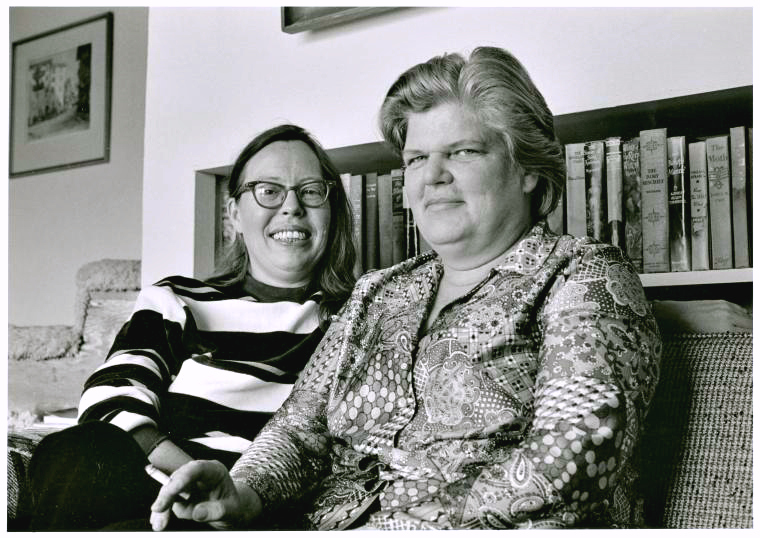
———
Phyllis Lyon and Del Martin’s work didn’t end with the Daughters of Bilitis. They had a long career of activism that included their work with the National Organization for Women, the Alice B. Toklas Democratic Club, and they fought for the rights of senior citizens. In 1989 they joined Old Lesbians Organizing for Change. And in 1995 they were named delegates to the White House Conference on Aging.
The two women were also outspoken in the fight for marriage equality and when they had the chance to legally marry, they did. Twice. First in 2004 when the then mayor of San Francisco, Gavin Newsom, ordered that marriage licenses be granted to same-sex couples. The California Supreme Court closed that window after two months and voided the marriages. They tied the knot a second time, on June 16, 2008, when the California Supreme Court ruled that same-sex marriage was legal.
Both times, Phyllis and Del were the first couple in line to be married. Del was actually married three times. Back when she was nineteen years old, she had married a man and had a daughter, Kendra Mon. That marriage ended in divorce after four years… and given the times Del didn’t even think to try to keep custody of her daughter. At Del and Phyl’s second wedding, Kendra and her husband Eugene sat in the front row.
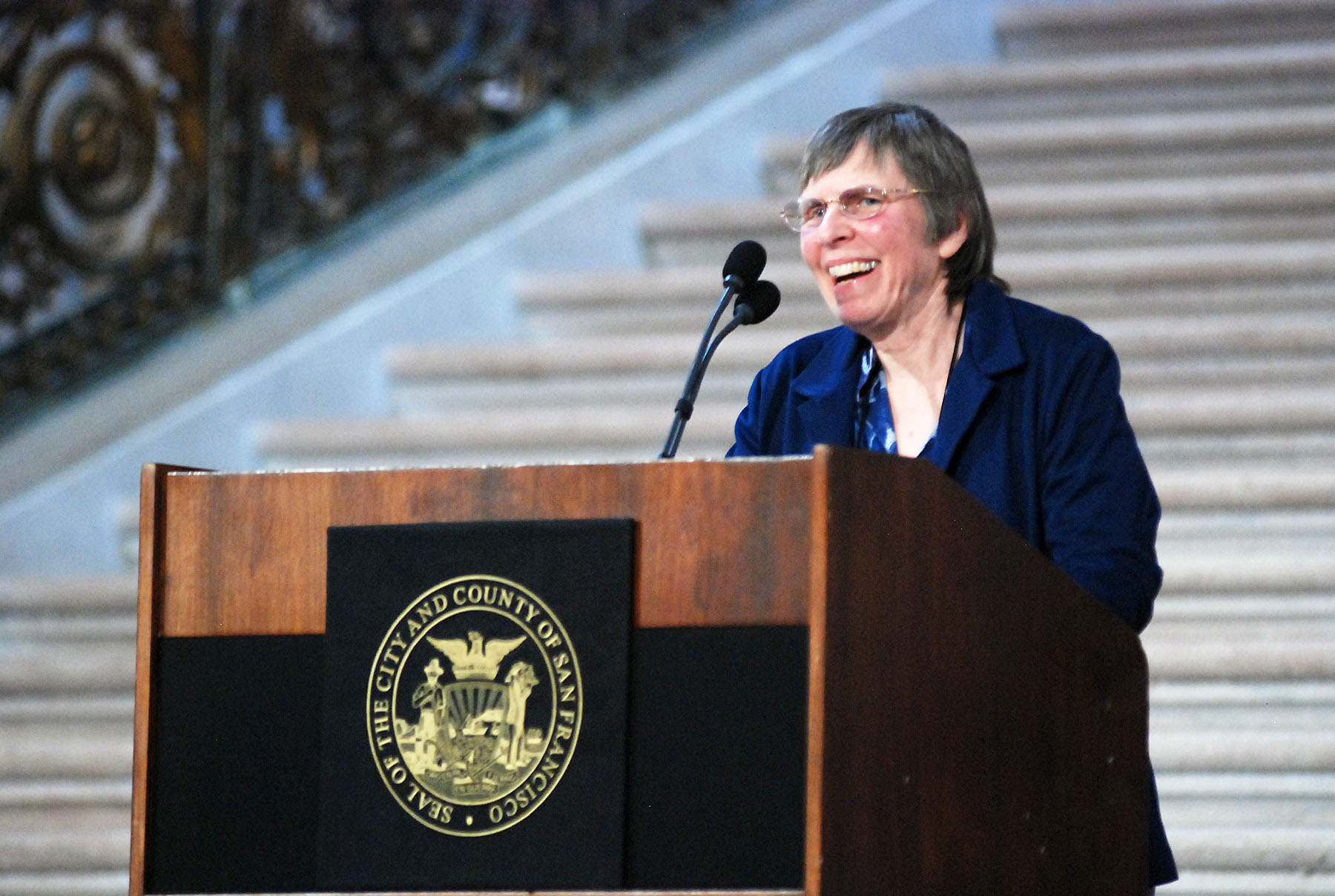
Del Martin, her full name, Dorothy Louise Taliaferro Martin, died on August 27, 2008 with her legal wife of two months, Phyllis Ann Lyon at her side. She was 87. San Francisco’s mayor ordered that the flags at City Hall be flown at half mast in her honor. Phyllis still lives in the Noe Valley house she shared with Del.
Making Gay History is a team effort. Thank you to executive producer Sara Burningham and audio engineer, Anne Pope. We had production assistance from Josh Gwynn. Our theme music was composed by Fritz Myers. Thank you, also, to social media strategist Will Coley, our webmaster, Jonathan Dozier-Ezell, researchers Bronwen Pardes and Zachary Seltzer. And thank you to our intrepid photo editor, Michael Green. A very special thank you to our guardian angel Jenna Weiss-Berman.
The Making Gay History podcast is a co-production of Pineapple Street Media, with assistance from the New York Public Library’s Manuscripts and Archives Division and ONE Archives at the USC Libraries.
Season three of this podcast is made possible with funding from the Ford Foundation, which is on the front lines of social change worldwide.
And if you like what you’ve heard, go ahead and write a review on Apple Podcasts or wherever you get your podcasts. Your reviews really helps other folks find us.
And if you haven’t subscribed yet, go to makinggayhistory.com for a full list of options. That’s also where you’ll find all our episodes, including photographs, notes, and links to additional information about the many people we’ve feature in Making Gay History.
So long! Until next time!
###